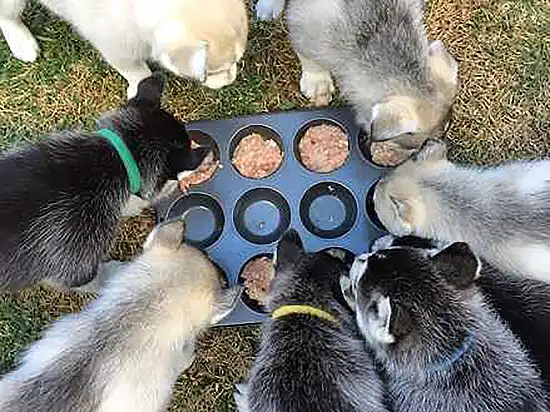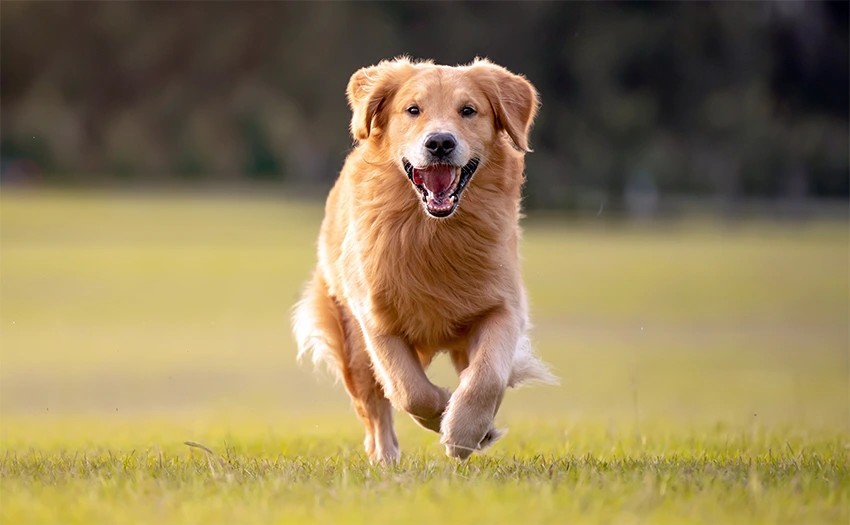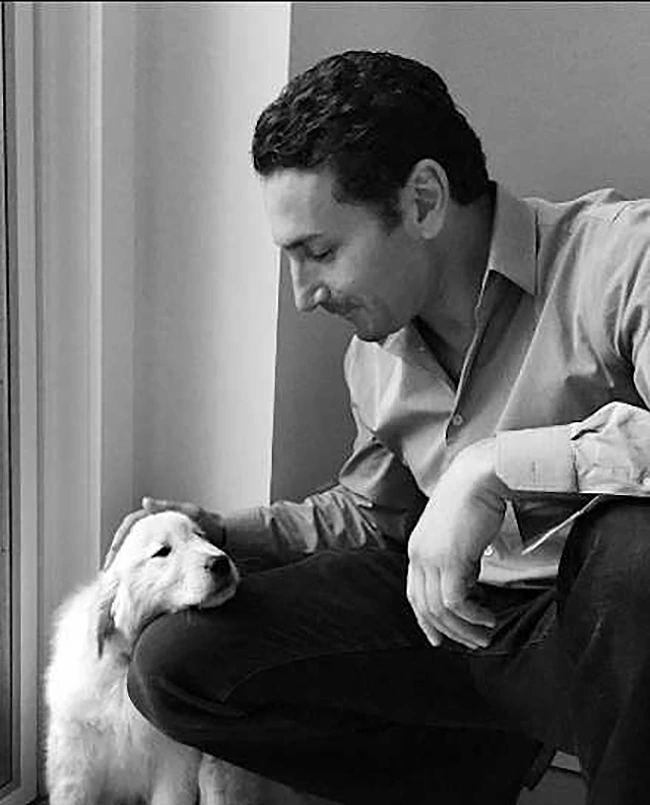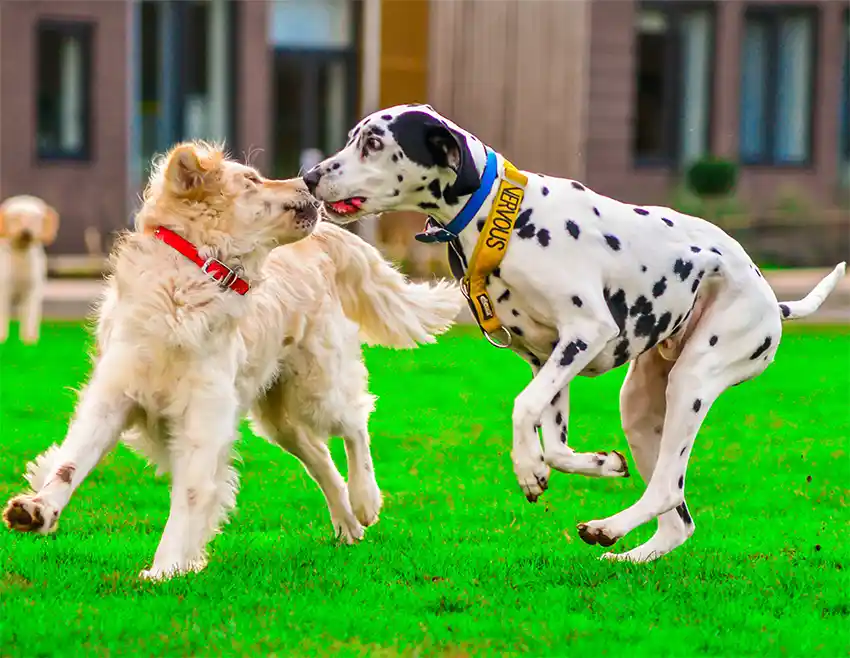These magnificent looking dogs are renowned for having one of the most stable temperaments of all the breeds, which is one of the reasons why they are so popular around the world. Their lovable nature and overall compatibility with humans, other dogs, and animals, is what makes this breed of dog one that people love. They are also one of the least likely to be aggressive or anti-social.
About the breed
The Golden Retriever is a large breed of dog, averaging around 25 - 35 kgs in weight, with a fun-loving nature that suits most people’s lifestyle. They learn quickly, they are great family pets and lifelong companions. They are strong dogs and hard workers, whether they are hunting, guiding, servicing, or performing search and rescue activities.
It is difficult to find a downside to this breed, but if we had to, we would say it might be their coat type, the care it requires and the shedding from the dense undercoat. However, this is a small price to pay for sharing your life with this magnificent breed of dog that ticks all the boxes when it comes to temperament.
History
Golden Retrievers were originally bred in Scotland in the 19th century to retrieve waterfowl and game birds. They were popular with the Scottish elite who loved hunting and needed an energetic dog capable of bringing the birds back unharmed.
As guns became more effective over long distances, more birds were being felled and the need for the perfect dog with the retrieval ability to help the hunter, became more important.
The breed had to be capable of navigating their way through rough terrain, over long distances, determined and undeterred, find and retrieve the birds where they had fallen and bring them back to the hunter intact. The Golden Retriever was excellent at performing these tasks and so their popularity as a great retriever grew.
Although they are still used in hunting today, Golden Retrievers excel at many other activities, including search and rescue and guide dog work too.

United Kingdom
The Golden Retriever was first bred in Scotland and then spread throughout the United Kingdom. The UK / British style of Golden Retriever is slightly different than the North American types, with thick coats and larger body weight.
British type Golden Retriever can be found in Europe and Australia and New Zealand. They have a larger and broader skull, larger chest and forequarters, and are more muscular than those found in the USA and Canada. The coat is generally lighter in colour than in the North American types, with the blonder colour being very popular in Australia and New Zealand. The darker colours of gold, red or mahogany are hardly ever seen in Australia and New Zealand.
United States
In the USA, in 1938, the Golden Retriever Club of America was founded. Golden Retrievers are ranked number two for American Kennel Club Registrations. According to the pure-bred dog guide, recognised by the American Kennel Club, Golden Retrievers are judged based on a variety of traits such as, colour, coat, ears, feet, nose, body, etc.
Canada
The Honourable Archie Marjoribanks took a Golden Retriever to Canada in 1881, and registered 'Lady' with the American Kennel Club in 1894. These are the first records of the breed in these two countries. The breed was first registered in Canada in 1927, and the Golden Retriever Club of Ontario (GRCO) was formed in 1958. The co-founders of the GRCO were Cliff Drysdale, an Englishman who had brought over an English Golden Retriever, and Jutta Baker, daughter-in-law of Louis Baker, who owned Northland Kennels. The GCRO in later years expanded to become the Golden Retriever Club of Canada.
Water Safety

Golden Retrievers love the water, and they don’t take much coercing to get them swimming. This comes as no surprise considering their origins. As dog owners, it’s our job to make sure they are safe.
If you have a pond or pool in your garden be sure that your dog is trained to safely exit. We call this "pool safety".
You may well ask, why would a Golden Retriever that can swim efficiently, need pool safety training?
They need be able to locate the steps of a pool or the bank of a pond or lake, as some dogs stubbornly try to exit the way they went in, which may not be the way out.
It is hard-wired in domestic dogs, as it is in the wild dogs, that when they fall into a creek or a river, they would instinctively attempt to exit the water at the exact spot where they entered or fell in. This is nature’s way of protecting them for those times when they fall through the ice while manoeuvring frozen creeks or rivers. A fall into icy water could be fatal and the instinct is to get out quickly, not to swim around and find another option.
Steps to make your Golden Retriever safe around water
Start water training as soon as your new dog or puppy is venturing outside and near to water. Fit a firm collar and long lead to your puppy or dog and let them enter the water and swim around for a little while. Now gently guide them, using the long lead, to the bank of the water, or where you know they can exit with ease and allow them to exit on their own. You are conditioning your dog or puppy to locate the right way out of the water.
If you help them, you can slow their ability to be able to get themselves out of trouble if ever they were to fall into a pond or pool, and you are not there to help them.
Once you see that your dog can exit easily, then start having them enter at different points, still attached to the lead. Make sure that they can work out how to swim towards the exit or bank and get out of the water safely.

Differences Between the Males and the Females
The males are generally larger than the females and can be quite physically strong, more muscular and outgoing. Their overall personalities are similar but males are generally more extroverted, whereas females are more reserved and tend to need more encouragement initially, especially when it comes to training.
Females are more likely to use passive influence on their owners than the males.
The females will still call ‘all the shots’ with any male dogs in the home. This is not always easily spotted as they tend to use subtle body language that can go undetected by the untrained eye. The male dog will usually be aware of this behaviour and act accordingly, with great respect.
The female’s control of the male is pretty much consistent throughout the canine world and the females tend to rule the roost.
The males excel at obedience, agility, and gun dog work, where the females need more encouragement, gentle persuasion, and guidance. They need patience and time to bring out the best in them. Just as the males will bound into their work with relish it, the females may need a little bit of coaxing to get the best out of them.
However, once they know what you want and feel confident about you and what you are trying to teach them, they do very well and are usually more focused on pleasing you.
One or two dogs?
As dog trainers, we are often asked the question, should I get one or two puppies or dogs? Some people want two, so they have playmates and don’t suffer from being "the only child".
The answer is always the same. If you want more than one puppy you can get two, but one by itself is fine. There is no getting away from the fact that a dog is a pack animal, and they are not a solitary animal, but they bond to you and their family the same way they bond to other dogs. They can also just as easily bond to another animal if they are introduced properly.
For example, a puppy and a kitten make good companions if introduced correctly from an early age.
Grooming
Due to the Golden Retriever's lush coat, they need to have regular grooming and brushing to keep them looking beautiful.
Nail care
Golden Retrievers need their nails clipped at least once a month. Start out using a treat to accustom them to the clipping procedure.
Don’t rush in and grab your puppy's foot and start clipping immediately. This alarms most dogs, and they will automatically try to pull back, bite your hand and a tussle begins. If your puppy begins to fear nail clipping early on it can lead to a lifetime of headaches.
Start off by picking up your puppy's paw, offer a treat and let it go. Once your puppy accepts this, they may begin to lift their paw just to get the treat. Now you can produce the clippers, just take the paw, touch the puppy’s nail briefly with the clippers, offer a treat and let go and lavishly praise. Never grip your puppy’s paw on the pad as most dogs are ticklish there. Always grip them gently at the knuckle just above the paw. This is more comfortable for your dog, and they are less likely to resist.
Initially get your puppy used to you holding its paw and the clippers touching their nail. Begin by only increasing this process to clipping one nail. Offer a treat and lots of praise, just like they have done something fantastic. Then leave it until the next day and repeat the same procedure on a different nail.
Brush your Golden Retriever regularly. They should only need bathing four or five times a year, unless they get extremely dirty.
When you do bathe your dog, be sure to dry them thoroughly, followed by a brisk walk, weather permitting, until they dry completely.
Their ears should be checked regularly to avoid a buildup of wax and debris which can result in an infection.
Teeth should be brushed regularly too.
Everyday Illness and Injuries
Your Golden Retriever’s health concerns will change over the course of their life. A puppy might be more prone to swallow something they shouldn’t. A 2-year-old Golden Retriever may be more likely to rupture their knee ligament, and a senior Golden Retriever is far more likely to develop arthritis or cancer as they age. They also have personality and physical traits that may make them more prone to certain condition. A Retriever who loves to swim may develop an ear infection more often than another breed.
If you are ever concerned about your dog’s health, your local veterinarian is the place to go, no matter how small the question.
Genetic Health Concerns
Like many popular breeds, the Golden Retriever has its fair share of hereditary based issues, like hip dysplasia and elbow dysplasia. Most reputable breeders now have their breeding stock checked and scored by a vet for these hereditary ailments. You can request proof that the puppy you are purchasing comes from parents that have been checked for these issues.
As many other health issues are also hereditary, you should do some research on the ancestry of your puppy, and any common health issues of that particular breed.
Be Prepared
As a pet owner, you should expect to pay for basic veterinary care like vaccines, spay / neuter, and annual checkups. Many pet owners don’t consider the unexpected illnesses and injuries that can occur throughout a pet’s life, and they don’t prepare for them. Medical insurance can help a pet owner prepare.
The concept of medical insurance for pets is straightforward. Pay a monthly premium to be covered for eligible veterinary expenses. Every insurer is different, offering varied coverage with different plans, pricing options and limitations. Do some research and pay close attention to what is and is not covered, how often you can claim and the limit on the amount you can claim. Also if you are taking out pet insurance for a dog who is a little older, there may be previous medical conditions that will not be covered too.
Training
You can teach a Golden Retriever almost anything because they are highly intelligent and willing to please. They are very keen to learn new things and bond easily to their family members. Although they might initially be over-exuberant, they will soon learn to calm down and listen.
This breed is a lover, not a fighter
The most common behaviour problems Bark Busters is called in is to address, are barking, over-exuberance and food aggression. Rarely are we asked to address aggression towards humans or other animals in Golden Retrievers.
Aggression in the Golden Retriever
Although aggression is rare, we do see it in some fearful temperament types. This needs an experienced knowledge base of how to address these issues effectively through the proper techniques. Although Bark Busters has seen relatively few Golden Retrievers with aggression problems, this problem can be solved once we identify the reason behind it. We do however get quite a lot of ‘food aggression’ cases.
Food aggression

A Muffin Tray - The better way to feed a litter of puppies.
Food aggression is quite common in this breed, especially if they were not properly imprinted as a puppy. Some breeders like to feed their puppies from one large bowl which causes the puppies to push and shove each other to ensure they get enough to eat. This creates urgency in the puppy to rush its food and a feeling of being deprived. The puppy thinks that if they don’t fight for their meal, they will miss out.
This invariably leads to ‘food aggression’ which is jostling for position at the food bowl resulting in bickering, squabbling, and all out fights.
The ideal way to wean puppies of all breeds, is to have them eating from something like a muffin tray, so they all get an adequate opportunity to eat with ease.
You can also feed them with individual bowls. This way there is no feeling of urgency, no sense of feeling deprived, no fights and no jostling for position.
Barking
Golden Retrievers are a very vocal breed and barking issues are often a behaviour that Bark Busters is called to address.
Don’t allow your Golden Retriever to demand attention from you, by barking and then getting your attention or a response from you. They may bark to go outside, bark to get fed or bark simply for attention. If you tolerate these misbehaviours, it will only encourage your dog to bark more.
Bark Busters can tailor a dog training programme for you and your dog that will address any barking problem your dog has, using communication and leadership, kindness and understanding.
Recall - coming when called

Golden Retrievers are renowned for their ability to bound away without notice, leaving their frustrated owner looking bewildered and unable to get them back quickly.
This is a dangerous behaviour and something that could spell disaster for your dog.
If your dog has a recall problem, then start off on a long lead and condition your dog to stay close and to come back when requested.
Don’t allow your dog off the lead until you first teach them to come back immediately when called or this could spell trouble.
Temperament
The Golden Retriever is one of the safest breeds and most lovable. They make a great family dog and are loyal and trustworthy. Golden Retriever lovers know how lucky they are to have a breed of dog that has the all-round personality that fits into most situations with ease. Their temperament is generally very stable. If you choose a breeder who breeds ethically, you will have an all-around fun-loving dog, with a great temperament and overall grace and beauty.
Puppy Selection

Once you have decided that a Golden Retriever is for you, ensure that you select the right breeder or a reliable source from which to get your puppy. The ideal age to take your puppy away from its mother or litter mates is at 8 to 12 weeks of age.
Most ethical breeders will understand that puppies that are taken away earlier than 8 weeks, miss out on much needed education that occurs at this stage of life. There is also a lot to be learned from mother dogs at this stage, which serves to set up your puppy for life.
When selecting a puppy look for a one that has the right personality to suit you and your lifestyle. Avoid selecting the fearful puppy that hides away at the back of the litter, but also look to avoid the one that is bossy, biting and beating up on its litter mates. It might look cute, and you think it has lots of cheeky characteristics, but you will be that bossy puppy’s target when you take it home.
Look for the puppy that is sensible enough to not push or bite the others. You don’t want the wriggly guy that wriggles about when picked up or the one that bites and snaps at your fingers or feet. Instead look for the puppy that sits calmly in your arms if you want a better family pet that can bring you joy, not anguish as it grows.
Selecting the wrong temperament can cause you all sorts of problems. The fearful type will possibly be anti-social with visitors, and the bossy type will run rings around you.
Select well and enjoy your Golden Retriever for a long time. The average life span of a Golden is 10 – 15 years so he or she will be a companion for a large part of your life.

Bringing A Golden Retriever Puppy Home
It is best to bring a puppy home early in the day to allow it time to settle into its new environment. Try to obtain something that is familiar to the puppy like a piece of bedding or a favourite toy.
Select a place for your puppy to call its own. A crate or strong box is best or a small secure room. You might want your puppy to share your bed or sleep in your room, but this can be disruptive as your puppy grows and develops and takes exception to not being able to share your bed anymore.
Also, give thought to the fact that the puppy that starts out this way may never be able to be left alone. Bark Busters treat many cases of Separation Anxiety and one of the most contributing factors is people who sleep with their dog, either in their bed or in their bedroom.
We recommend that you provide your Golden Retriever puppy with a bed of its own, in a place of its own if you want a dog that can be left alone without incident.
Addressing Puppy Barking
It is not advisable to ignore any barking your puppy might do when left alone. This will only serve to make the situation worse. You must stay close by and reassure yourself that the puppy is not trapped or in any real trouble. Once you know that, then address any barking.
It is far better if the puppy knows you are there and close by. However, don’t immediately rush into sight every time your puppy barks or cries as that will only cause your puppy to cry out anytime it wants to see you.
Toilet Training Your Golden Retriever
The results you achieve will depend on how your puppy was imprinted when it was still with the litter. Some breeders have their puppy’s toileting on puppy pads or newspaper, or some use dedicated areas with cat litter or sawdust.
Once a puppy is imprinted on a particular surface it remembers the smell of that surface and it’s permanently imprinted on the brain. So, they will seek out that smell again when they need to toilet. Dogs that are reared outdoors and on grass or dirt, will likewise seek out the same smell once more to toilet, which is more conducive to healthy toilet practices.
Dogs can be trained to toilet outdoors and on appropriate surfaces, but it takes time, patience, and effort. It is best to ensure that the puppy you select has been raised and imprinted properly and on the appropriate surface.
We do recommend artificial grass as a good functional alternative for toilet training, as this has a strong smell that attracts dogs to it to toilet. It’s also washable and durable.
Four Basic Needs
Your dog has four basic needs in life to keep it happy healthy and content.

Let's examine those four basic needs and why your dog needs them to keep it healthy, balanced and content.
Food - diet / nutrition
We promote a diet that is grain free, low in carbohydrates and without any harmful e-numbers, colours and preservatives. Carbohydrates do add energy that the dog needs to burn off and can make an already hyperactive dog more active.
The right diet, grain free and filled with fruits, vegetables and raw meat will have advantages to how your dog will feel, look and act.
If you want to understand why grains can make a dog more energetic, you only need to think of racehorses and how their trainers give them grain to get highly energetic racehorses. Energy in, equals energy out.
Bark Busters dog trainers are not vets or dietitians, so we urge you to do your own research into the best diet for your Golden Retriever. A diet that you will be comfortable with.
We do however have vast experience at how highly concentrated grain diets effect behaviour and can cause hyperactivity. This is very prominent in Japan, where most dogs are fed high levels of rice in their diet which can adversely affect concentration and focus.
Safety - through leadership and education
All dogs need strong leadership and to know where they fit into the family unit. If they know they have a leader that will make all the decisions, one who is fair and just, they will be happy and content.
On the other hand, if they have no structure in their life, they have inconsistency, and don’t know how things will be from one day to the next, then they will become stressed and may experience health ailments, skin and stomach issues and behaviour problems. Routine and respect must be established. With equal doses of love and structure your Golden Retriever will feel safe and secure.
Shelter - a place to call their own
Dogs love nothing better than to curl up on the couch or in a place they can call their own, even when there is more than one dog. Golden Retrievers are very sociable, and they will think nothing of all snuggling in together. Provide your dog with its own "den", a place where they can call home, and somewhere they can go to for a bit of peace and quiet. Just make sure their "den" is warm, easy to clean and maintain.
Entertainment - toys & games
A very important part of your dog's four basic needs is their need to have something to do. If we want to avoid our pets becoming bored and destructive, then they need a way to fill their day.
Dogs thrive with physical and mental exercise. Dogs are highly intelligent animals, and they need to keep their brains active as much as their bodies. Entertainment is an important part of their well-being and essential to your dog's overall mental health.
One great toy is the Bark Busters GameChanger® which helps to prevent boredom, stress, and separation anxiety. By filling it with small treats, your dog will have plenty of fun trying to get the treats to dispense. Also, retrievers love to play fetch so have numerous tennis balls on hand too.

Puppy Training
Any training of a puppy must be gentle and dog friendly. Puppies need special care because they are experiencing everything for the first time. They are very impressionable in the first year and need patience and understanding to set their education on the right path.
Bark Busters trainers are very experienced at dealing with all puppy issues. Our puppy training takes a positive approach and it's not a 'one size fits all'.

Bark Busters' trainer working with a puppy.
Our trainers assess the personality of the puppy and tailor the training to suit the puppy's personality and the owner's needs.
We assess the way a puppy is behaving and advise on how to manage common puppy issues, such as toileting and destruction.
Puppies need to be managed, have structure in their life, education, entertainment, and the right nutritional diet. They also need regular vet checks to keep them healthy and happy.
Dog Parks
Ensure that your puppy encounters only the very best of experiences when it meets other dogs outside of the home. Bark Busters feels it is not wise to take a young puppy to a dog park or a place where you are likely to meet many adult dogs. Why? In our 35+ years of experience and the training of more than 1 million dogs worldwide, we have found that young puppies are very impressionable, and any bad experience they encounter will stay with them forever. If you absolutely feel that you must take your dog to a dog park, wait until it reaches 12-months of age. Older dogs can cope much better with trauma, than young adolescent dogs.
Some adult dogs can frighten and intimidate a young puppy which can leave them with a lasting adverse impression of other dogs. These traumatic experiences can lead a puppy to grow into a reactive or aggressive dog as they grow and mature. This is not the way you want your dog to start its life, afraid of every dog it meets or acting up every time it spots a strange dog coming towards it. Bark Busters dog trainers deal with many cases of aggression towards other dogs that started following a bad experience or incident at a park.
Carefully select which dogs you want your puppy to socialise with, based on that dog's temperament. Avoid over-exuberant dogs or those that like to bully or dominate young dogs.

See if you can arrange 'play dates' with friends who have calm, friendly dogs that won't want to beat up on your puppy and those dogs that are tolerant of puppies or adolescent dogs. This will pay dividends later and will set your dog's education on the right path.
Scene stealers
The Golden Retriever is one of the most glamorous breeds and gets attention wherever they go. They will steal the scene but won't embarrass you. In fact, that's why Golden Retrievers were chosen in the popular movies 'Airbud' and 'Homeward Bound'.
Bark Busters Lifetime Support Guarantee
Bark Busters dog behaviour therapists and trainers have trained more than 1 Million dogs worldwide and are renowned authorities in addressing dog behaviour with all-natural, dog-friendly methods. The Bark Busters training is the only service of its kind to provide International dog training guaranteed lifetime support. With hundreds of trainers around the world, Bark Busters continues its mission to enhance the human/canine relationship and to reduce the possibility of maltreatment, abandonment and euthanasia. Contact your local Bark Busters dog trainer to see how they can help.
This article is the copyright of Bark Busters® and is intended for information purposes only. Dog owners should fully research any problems that they may have with their dogs.
